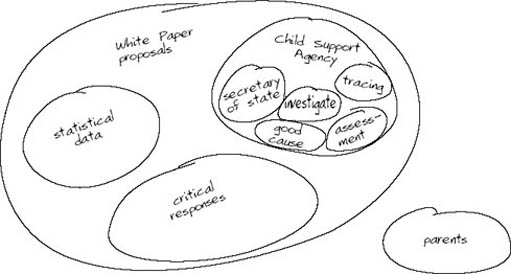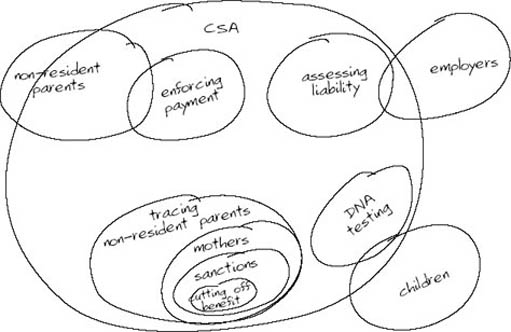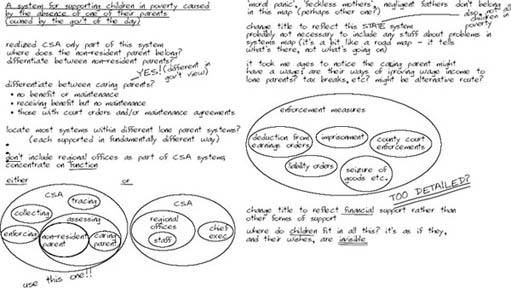9.3 Systems maps: Drawing systems maps
The next step is to draw some systems maps. The art of drawing effective systems maps lies, I believe, in finding an appropriate balance. The balance lies somewhere between the learning, which comes from the process of drawing the maps, and the uses I might make of the end product.
If you have already had some experience of drawing systems maps, you will know the process generates insights and understanding by itself. This comes from having to decide what to include and what to exclude; deciding where components are located; redefining boundaries; and sometimes starting again.
It is often tempting not to bother with the final drawing once these insights emerge. It is usually worthwhile pursuing the process to a final version of each map, however. Some insights only emerge once the map seems to be complete. It is equally possible to be so focused on the final map all the insights get lost or forgotten, even if they are incorporated into the map. In the activities that follow, it would be useful to pay equal attention to both the process and the product.
SAQ 3
State the main defects in the systems maps relating to the case study shown in Figures 10(a) and 10(b).
Answer
There are several problems in Figure 10(a). The first one that I spotted was the secretary of state is not part of the Child Support Agency. There is some confusion about systems and subsystem here, at the very least. I didn't think the secretary of state was really a system as such. I was also concerned about whether the White Paper proposals could be regarded as a system-with-purpose; I wasn't sure they could. In this case, the diagram seems to simply illustrate the structure of the White Paper. It is more like a structure or organisation map.
I suspect the diagram would be clearer, and make more sense if the system of interest were relabelled. This idea is confirmed for me by the inclusion of ‘statistical data’, which doesn't seem to be a proposal, although it was part of the White Paper. The critical responses were certainly not part of the White Paper proposals or the White Paper. It may be they might have a better role in an influence diagram on the outcomes of the White Paper proposals. I then checked back to see what the White Paper proposals were. The establishment of the CSA was the only one mentioned. I wondered why ‘parents’ had been included as a system in the environment, which, by implication, influences the system of interest. If it was really an influence on the White Paper proposals, what about the other influences?
Figure 10(b) seems to have a clearer structure although some subsystems seem to be out of place, missing or inappropriate. I was also concerned about the subsystems that overlap both the main system and its component subsystem. This is very occasionally allowable but almost always is best avoided. While non-resident parents are not part of the enforcement subsystem of the CSA, they may feel its effects.
DNA testing is clearly one of a number of components of the tracing subsystem, mothers are not. You can tell they are not by saying ‘mothers are a system to…’ and then seeing if there is any completion that will contribute to a purpose such that mothers are part of a tracing-non-resident-parents system. There were many other components that belong in the tracing-non-resident-parents subsystem and the ‘mothers’ system seemed to contain many subsystems and sub-subsystems than any other subsystem in the diagram. It has not got a title.
Expect to take about an hour for the next activity. Allow about twice as long if your experience of systems maps is limited or non-existent. If you find yourself taking very much less time, it is possible your map is not really representing the situation. Creating structure in complexity takes considerable effort.
Activity 19
Choose one of the systems you identified in the activities above.
The basis for your choice isn't important at this stage but it might be useful to choose a system that seems to be central to the situation. This is your system of interest. Make a note of why you chose it – even if it's no more than a vague preference.
Draw a systems map of your chosen system. Use OpenLearn unit T552_1 Systems diagramming as a support and guide.
Make notes of the insights and understandings you gain as you draw your map.
Give your map a title. Does the map you have actually drawn match the title? It is common, and not unexpected, to find you have drawn a systems map different to the one you intended to draw. Iterate until your title and map match.
Be wary of drawing a systems map that simply reproduces an organisational chart. It should be purpose that defines the system and its boundary, not organisational structure.
Be wary of drawing a map of what would be needed for your system to achieve its purpose. The diagram you are drawing is a snapshot of the current situation.
Take particular notice when the temptation to break the conventions seems strong. This experience nearly always signals an important trap. Resist the temptation and look for ways around the problem other than breaking the rules – almost always the reward is an important new way of understanding the complexity.
Use your rich picture as a source, checking you have included all the items relevant to your system.
When you have completed the first draft of your map, check it rigorously against the rules and guidelines for drawing systems maps given in T552_1. You should think of this process as being much more than a check for compliance with the rules. It is one of the mechanisms by which you begin a dialogue with your diagram.
Discussion
There are dozens of different systems maps you could devise, don't think of mine as a best map in any way. I am simply showing you what I learned from drawing my map.
I started by identifying the CSA as being something that could be interpreted as an attempt to address an issue. There were all sorts of issues it might have been attempting to address. You can see my notes in Figure 11. I quickly identified some potential systems.

I chose to explore the second of my two systems, mainly because it looked the most straightforward. In Figure 12, you can see the notes I made as I explored this system. You will see I changed my mind several times as I went along. The first attempt at a systems map is shown in Figure 13.
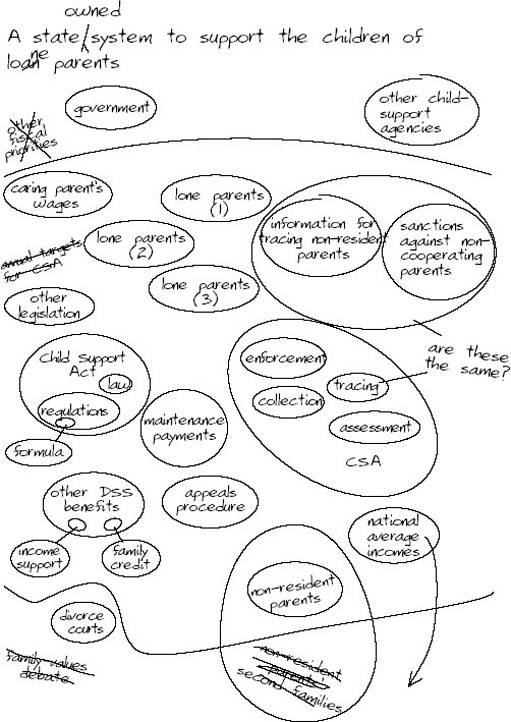
Figure 13 is incomplete: it's full of crossings out and the system boundary is tentative but it seemed to lead to some breakthroughs. I was aware I was going against some of the decisions I had made earlier but it was easy after the Figure 13 version to see my way to a much clearer system. I'd changed the title several times before I began to see a system emerging. Figure 14 is my almost-final version. It contains quite a lot of components and rather more levels of subsystems than I would normally expect to use. But despite all the detail, I decided not to simplify it – it worked for me as a way of locating lots of the elements. The map may need modifying as my understanding of the system improves.
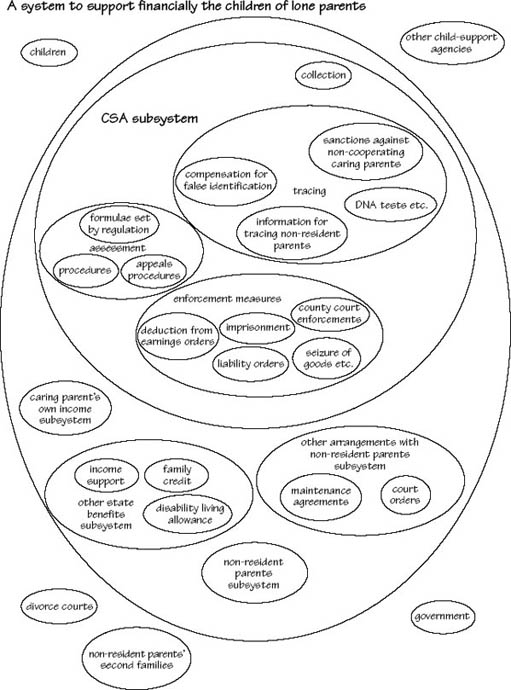
Spend 15 minutes on the next two activities, perhaps longer if it prompts some reworking of your map.
Activity 20
Review your systems map.
Check it is drawn from a perspective. Is it possible to deduce from it who the owner might be?
Is the purpose of the system evident? Are the intended beneficiaries (or victims) present in the map in some form? Is there anything in the environment that affects the functioning of the system?
If you are not sure these challenges can be answered, have another look at your map.
Compare your map with your rich picture. Does your rich picture prompt you to include any other elements in your map?
The test of a good map is whether it clarifies the complex situation. Does your map do this?
Activity 21
Review your system boundary.
Look at the system boundary you have drawn. Does it represent a boundary between the system and its environment? Is it clear the subsystems within the system are part of the system's working. Are your sub-subsystems part of the subsystem's working? Is it clear the elements outside the system boundary influence, or are influenced by, the system?
What happens if you move the system boundary? If you include other systems as subsystems, does that change the title and purpose of the system. Does this change the systems that must be included in the environment? Is the new system more, or less, useful in aiding your understanding? Record any new insights in your Learning Journal.
If you feel you need practice in drawing systems maps, you may wish to take another of the systems-with-purpose you listed earlier and develop a new map. Although this task may take some time, it will be time well spent if you need the practice. If not, use my map to compare with your own in the next activity.
Expect to take about 10 minutes.
Activity 22
Compare your map with mine or with a second map you have drawn.
Resist any temptation to use my map as the basis for evaluating yours. Notice the ways the different system purposes – as expressed in the title – lead to different structures and different elements.
Notice any differences between the beneficiaries identified, the actors or activities, the perspective, the owners and the elements in the environment.
Does the comparison prompt any questions?

